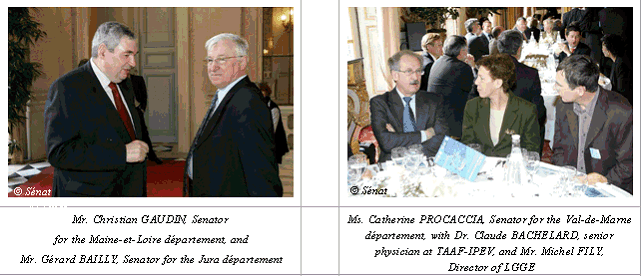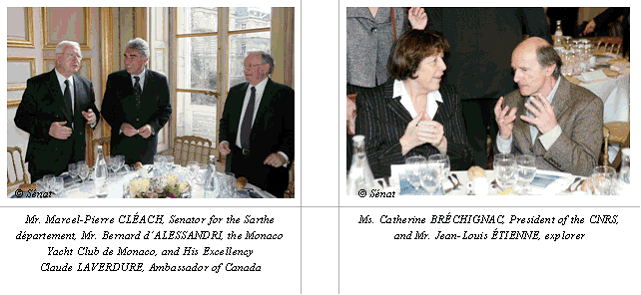SENAT
Report n° 230 (2006-2007) by M. Christian GAUDIN, Senator (for the parliament office for the evaluation of scientific and technological choices)
Disponible au format Acrobat (12 Moctets)
II. MR. JEAN-LOUIS ÉTIENNE
Ladies and gentlemen, it is a very great honour for me to be able to say a few words of welcome to the Senate on the occasion of the launch here in France of the International Polar Year.
A tribute to the commitment of men
I would first of all like to pay tribute to the commitment of men, by trying to shed some light on the following enigma: why this attraction to such inhospitable regions?
In this sensory-poor universe, where grey alternates between blue and white, in this odourless universe, without any sound other than that of the wind, man, freed from the world's constraints and stimulations, loses his bearings and has no other choice but to learn to tame himself. Forced to spend time with oneself, one never returns unchanged from a long journey through the great winter. This is perhaps a key to understanding the paradox of the irresistible attractiveness of the polar regions.
This meeting with oneself is generally expressed through writing or painting. The polar explorer fills his diary with the passing time, his feelings, his observations. One can paint or sketch, one can write in and tell anything to one's logbook, one's "trip confidant". In this manner, the first explorers brought back their watercolours from an until-then-unknown world, at a time not very long ago when photography and film were still in their infancy.
Often plagued by cold and hunger and an uncertain tomorrow, these pioneers found the courage to write some of the most beautiful pages expressing the until-then-unsuspected heroism of human nature. They taught us that one discovers, rather than pushes back, one's limits.
Thus, the polar regions have produced their heroes, painters and writers, and it is in this manner that this icy world entered the popular imagination, with igloos and bears still furnishing childhood's most beautiful dreams.
The North and South Poles: differences and similarities
In popular culture, these extremes are mixed up and combined in the same clichés, while they are in fact quite different. In the north, a deep ocean surrounded by land and covered by an icecap a few metres thick. In the south, the Antarctic continent: an immense ice sheet 3 km thick and 28 times the size of France, surrounded by the Antarctic Ocean and its legendary winds.
The ecosystems of these two poles are different, but the species which live there share a remarkable adaptation to the climate, to the winds, to the distances they need to cover to access the necessary resources, to the bareness of their reproduction areas open at all times to the weather and predators, and to the short summer which forces them to rapidly raise their young before the sudden arrival of winter. Throughout the millennia, these polar species have won the biological bet of being able to successfully establish themselves at the frontiers of life, frontiers which today we are transgressing.
Careful - in these powerful lands, the species are fragile.
A treaty for the Antarctic
For long terra incognita , the poles were the last regions to reveal their secret. Lost at the ends of the Earth, they practically never appear on world maps - and yet, they arouse our desire.
At the end of the Second World War, Antarctica was the distant centre of diplomatic tensions, fueled by territorial claims: Chile, Argentina, Australia and New Zealand claimed the continuation of their coasts onto the "white continent", while England, France and Norway emphasized their Antarctic discoverers; the United States and the Soviet Union claimed no territory, but reserved all the rights.
Within the framework of the International Geophysical Year, the third International Polar Year was decided. Twelve nations - including France, motivated by the French polar expeditions led by Paul-Émile Victor - set up permanent scientific bases in Antarctica. As part of this great federating impulse, all the researchers from all of the countries which in 1957-1958 set off on this adventure were ordered to share their results. In the very heart of the Cold War, free from all national ambitions, this remarkable international cooperation led to the signing of the Antarctic Treaty, making the austral continent a land of peace dedicated to science. The main objective of this treaty was to ensure, for the future generations, that Antarctic remain forever occupied for pacific ends and never again be the subject of disagreement. Since its signature and its renewal in 1991, the territorial claims have been frozen, all military and nuclear activities have been forbidden, and researchers have been obliged to share their results. The Madrid Protocol on environmental protection forbids the exploitation of Antarctica's potential mineral and oil resources until 2048.
There you have, ladies and gentleman, what the previous International Polar Year bequeathed to mankind: a peace treaty, an exemplary model of management at the world-level, and this founding act was only made possible by its having been the fruit of a united scientific community.
As climatic indicators and actors, the poles call for planet-wide protective measures
Today, the state of the world has changed and the polar regions are at the forefront of the ever-increasing threat posed by climate change. In our understanding of the phenomenon, the polar regions are no longer only distant indicators of global warming, but also actors in the climatic disharmony which will progressively weigh on our future and the future of all the world's ecosystems. Because everything that affects the poles affects the world, and vice versa.
The International Polar Year that is now opening will allow for an inventory to be made of the human, geopolitical, biological and environmental impact of our civilization - an impact which is unfortunately already known to us, particularly in the Arctic.
Strengthened by this expertise which will have an impact around the world, let us hope that following the example of the previous International Polar Year - which resulted in the Antarctic Treaty - the scientific community, strengthened and united behind this report and supported by the latest IPCC report, let us hope that the scientists will manage to develop, under the banner of the International Polar Year, a solemn call that will serve to convince all the decision-makers - both industrial and political - of the urgent need for each of them to carry out, in their respective fields of action, the necessary environmental measures, that fears for their sector-based and national interests are no longer appropriate, and that by immediately taking these measures, the future will prove them right.
It's a great challenge that this International Polar Year can take up, by relying on the universality of the poles, these points of convergence where the meridians of all the nations meet.









